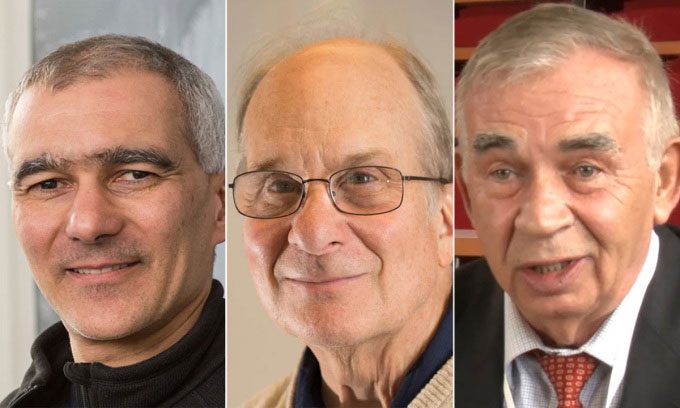The 2023 Nobel Prize in Chemistry has been awarded to three scientists for their research on quantum dots, the smallest components of nanotechnology, which are used to transmit light from TVs and LED lights, and illuminate cancerous tissues for surgeons.
At 4:45 PM on October 4th (Hanoi time), the Royal Swedish Academy of Sciences announced that three scientists, Moungi G. Bawendi, Louis E. Brus, and Alexei I. Ekimov, are the recipients of the 2023 Nobel Prize in Chemistry.

The three scientists Moungi G. Bawendi, Louis E. Brus, and Alexei I. Ekimov receiving the 2023 Nobel Prize in Chemistry. (Photo: CNN)
Moungi G. Bawendi (62 years old), born in France, is currently a professor at the Massachusetts Institute of Technology (MIT) in the United States. Louis E. Brus (80 years old), an American, is currently a professor at Columbia University in the United States. Alexei I. Ekimov (78 years old), born in the Soviet Union, received his doctorate from the Ioffe Institute of Physics and Technology in Russia in 1974 and was previously the chief scientist at Nanocrystals Technology in the U.S.
Chemistry researchers know that the characteristics of an element are determined by its number of electrons. However, as materials shrink to the nanoscale, quantum phenomena arise and are influenced by the size of the material. The 2023 Nobel Prize winners successfully produced particles small enough that their characteristics are determined by quantum phenomena. These particles, known as quantum dots, are now of immense importance in nanotechnology.
“Quantum dots have many interesting and unusual characteristics. Importantly, they have different colors depending on their size,” said Johan Åqvist, chairman of the Nobel Chemistry Committee.
Physicists have long known that, in theory, quantum effects dependent on size can occur in nanoparticles, but at that time, it was nearly impossible to control nanoscale sizes. Therefore, very few believed that this knowledge could be applied practically.
However, in the early 1980s, Alexei Ekimov successfully created size-dependent quantum effects in colored glass. The color comes from copper chloride nanoparticles, and Ekimov demonstrated that particle size affects the color of the glass through quantum effects.
A few years later, Louis Brus became the first scientist in the world to demonstrate size-dependent quantum effects in freely floating particles in liquids.
In 1993, Moungi Bawendi revolutionized the production of quantum dots, resulting in almost perfect particles. Such high quality is essential for the use of quantum dots in various applications.
Quantum dots are now used to enhance the brightness of computer and TV screens based on QLED technology. They also add nuances to the light of certain LED lamps, and biochemists and doctors use them to map biological tissues.
Thus, quantum dots provide tremendous benefits to humanity. Researchers believe that in the future, they could contribute to the creation of flexible electronic devices, tiny sensors, thinner solar panels, and quantum-encrypted communication. Humanity has only begun to explore the potential of these tiny particles.
This year’s Nobel Prize winners will receive a prize of 11 million Swedish kronor (approximately $986,000), an increase of one million Swedish kronor from 2022.
The 2022 Nobel Prize in Chemistry was awarded to three scientists Carolyn R. Bertozzi (USA), Morten Meldal (Denmark), and K. Barry Sharpless (USA) for their research on the development of click chemistry and orthogonal chemistry, applied to cell exploration and improving cancer treatment.
- 2023 Nobel Prize in Physics honors research on electron particles
- mRNA Covid vaccine research wins the 2023 Nobel Prize in Physiology or Medicine
- How fast is an attosecond?
- Norwegian author Jon Fosse wins the 2023 Nobel Prize in Literature
- Iranian women’s rights activist wins the 2023 Nobel Peace Prize
- 2023 Nobel Prize in Economic Sciences honors American female professor


















































